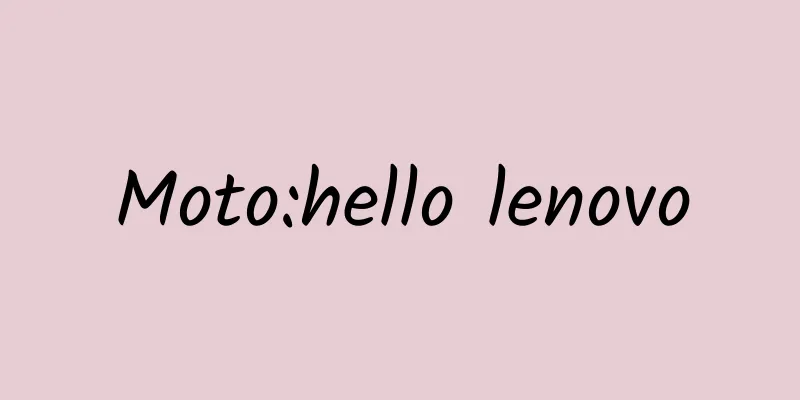Moto:hello lenovo

|
Last September, when Motorola Mobility (hereinafter referred to as Motorola) released Moto 360, I went to Motorola's headquarters in Chicago with many foreign media. It has spacious and bright offices, open workstations, exposed pipes on the roof, but many of the layouts are particularly elaborate, with bright graffiti in the corridors, free snacks in the tea room, and even a Chicago subway map made of LED tubes on the wall, which shows the traffic conditions of the Chicago subway in real time, which is very cool. This makes it look like a young startup in Silicon Valley, rather than an 86-year-old old mobile phone manufacturer that is undergoing a difficult transformation.
Motorola's PR took us on a tour. The office was full of green Android robot logos, dolls, models, stickers... on the desks, hanging at the door, in the corners, all of them. Just like its former parent company - Google.
At that time, Motorola had just moved to the top of the Merchandise Mart in Chicago. This is an 80-year-old building located in the city center, very impressive. Motorola's previous location was in Libertyville, a suburb of Chicago. To put it in a metaphor, moving here is like moving from Songzhuang to Guomao. This was Google's request. It hoped that Motorola, which was already losing ground in the smartphone market at the time, could get closer to young people and consumers and win back the hearts of the mainstream market. Relocation was a huge project. According to the statement at that time, Motorola invested $300 million in the relocation, involving 3,000 employees, two-thirds of whom were engineers. They rented the top three floors and the roof of the shopping mall for 15 years, covering an area of 600,000 square feet. However, what cost more than rent was moving the original laboratory and all the equipment from the remote suburbs to the new office in the bustling area. The project was announced in July 2012. In order to accommodate so many employees, Motorola even had to persuade the 120 owners of the original building to relocate. So the office was not officially put into use until September 2014. But it is a bit ironic that by then, Motorola no longer belonged to Google - it was sold to another company with a completely different culture. The news of Motorola's resale was actually officially announced on January 30, 2014. That time was the Chinese New Year's Eve, the most grand traditional festival in China. The buyer was also a Chinese company, Lenovo. It spent $2.9 billion to buy Motorola, which had few patents left, from Google. I don't know why, when Motorola moved into the new office, despite having a new parent company, the elements of Android and Google were still everywhere. Maybe it was already arranged before the acquisition was announced; or maybe it was in the transition period and they didn't have time to adjust and change. But it was at that time that Motorola released three of its most important new products: the second-generation Moto X and Moto G phones, and the current benchmark product in the wearable smart device market, the Moto 360. These are also products with a deep Google imprint: Moto X focuses on the native Android experience, Moto G is a device for emerging markets, and Moto 360, which was born out of Android Wear and is also its representative work, is the product of close cooperation between the Motorola team and Google's X Lab. I still remember at the press conference, the engineer who was responsible for showing the Moto 360 told us very proudly that this can be said to be created by them and the Android Wear team. Before launching this product, the two sides were working together like a team. Even the strategy of "only promoting high-quality products" itself is a legacy from the Google era. After being acquired by Google, the number of new devices launched by Motorola has dropped sharply. It is said that Google canceled nearly 20 smartphones of different positioning from Motorola at that time, and asked them to streamline their product line, stop producing low-end devices, and focus on a few mobile phones instead of producing dozens of devices at the same time. Not only that, Motorola also announced to its employees that it would lay off 20% of its employees, which is about 4,000 people. Google also reorganized Motorola's management, removed 40% of its vice presidents, hired new executives, withdrew from unprofitable markets, closed one-third of its 94 offices around the world, and concentrated R&D in its headquarters in Chicago, Sunnyvale in Silicon Valley, and Beijing. After a series of measures, we have the Motorola we see at that time. At that time, it seemed that Motorola was still a Google company. However, not long after I came back from Chicago, Lenovo announced the completion of its acquisition of Motorola in about two months. Although I was curious about what kind of changes would happen to the Motorola office, I had no way to go and see for myself. Until last week, when we and other Chinese media came to this office again, we found that everything had changed. The word Lenovo was written on the door, and the words under the Motorola logo changed from "a Google Company" to "a Lenovo Company".
The hall was filled with Hello Lenovo logos, and even the "messages" from Lenovo's top executives were made into banners and hung above people's heads along with their names.
More importantly, the Android doll stickers that filled the office have disappeared. In the Motorola product display area, there is an Android doll, as if it represents the more than two years that Moto has been under Google. In the design lab, I saw five or six familiar "green robots" - but that's nothing. There are so many models in the design lab. I dare say that there are more character figures from "Star Wars" and "Guardians of the Galaxy" than Android models.
People no longer talk about Google—at least not to those of us who are obviously from China. When they do talk about it occasionally, it’s in a very businesslike tone. The management said in a press conference tone that Google is our partner and that this will not change. We will work together to launch good products. And what about the engineers? An engineer from Motorola told me that they were actually very happy when they were first acquired by Google. They felt that having such a large parent company like Google meant they had a backer, and that maybe in the future there would be more resources and preferential treatment on Android, but that didn’t happen. Talking about the past, there is a slight regret, but it seems okay. However, Lenovo is a new name to the people who work here. Perhaps a year ago, they had not heard much about this company. Many of the computers in the studio were Dell. A Chinese engineer told me that after the acquisition was announced, many colleagues were confused about what Lenovo did, and some even came to ask him. Members of the Motorola China team also said that they prepared a lot of information on the intranet to help people solve their doubts. Even though the influence of Google is still there, such as the idea of shutting down many product lines and focusing on one or two high-quality products, it seems that Lenovo will continue to stick to it. However, people are getting busy and excited because Lenovo has brought a bigger variable - China. Motorola, which had once withdrawn from the Chinese market, is like giving away a big piece of cake. Whether it was at the previous Motorola return to China press conference or at the reception of our senior vice president of design Jim Wicks and senior vice president of engineering Iqbal Arshad, they repeatedly said, "We are very happy and excited that Motorola is about to return to China."
They described the future of Motorola in China - China's huge market, Motorola's brand influence, plus Lenovo's channel strength, make this combination seem very powerful. Iqbal Arshad is also full of confidence in the future. He said, "With our strong design concept and engineering technology level, Motorola will come back very confidently." In his opinion, the core advantages and differentiation of returning to the Chinese market are mainly the following: the first point is personalized customization. They will manufacture products that are more suitable for consumers according to their needs; the second point is that the products will bring users the best and most comprehensive user experience; the third point is that Chinese consumers will experience high-quality and highly reliable hardware; the fourth point is that our products have the best industrial design; the fifth point is that we will do our best in software and Android system optimization. However, this is just a variable and cannot be considered a change. China is no longer the same country that it was when Motorola withdrew. Apple still has a large number of fans, but Samsung has begun to lose ground. On the contrary, domestic brands such as Xiaomi and Huawei have begun to seize the market, becoming an increasing threat to Lenovo and Motorola. In addition, operators have been reducing subsidies to mobile phone manufacturers, and Lenovo, which has an advantage in channels, has also been greatly affected. In addition, consumers are also changing. People still have a vague understanding of the overall experience, but have learned to make a table to compare the configurations of various mobile phones: the number of core chips, the number of pixels of the camera, and even the system updated every few weeks are all factors that determine the purchase; from feelings to participation, domestic manufacturers have become more and more familiar with how to gather fanatical fans around them; but Motorola's excellent industrial design combining software and hardware, cutting-edge user experience, and even strong R&D capabilities reflected in many details, which require a lot of energy to promote and educate, may be perceived and accepted by people outside the technology circle. Another thing that cannot be ignored is that the Chinese market is more like "looking good". It has actually begun to tend to be saturated, and many Chinese manufacturers, including Lenovo, have begun to seek to expand into overseas markets. Therefore, although Motorola claims that its revenue grew by 100% last year, and it has achieved good results in India and Brazil, this old company, which has not yet recovered from its sluggish performance, still needs greater stimulation to regain its vitality. The Chinese market is obviously that shot in the arm, but whether it can really make this once giant regain its vitality after the shot in the arm remains to be seen. But no matter what, Lenovo brought good news. People were full of expectations. Insiders told me that they had made a lot of careful preparations for the visit of Chinese guests, rehearsing several times from the visiting process to the details. Many people learned to greet in Chinese. Whether it was the laboratory director who participated in the explanation or the ordinary engineer - this was spontaneous. Mike, who was in charge of the mold laboratory, even wore a badge with the American flag + the Chinese flag. Because they need to cater to both the global and Chinese markets, the Chinese engineer who led us on the tour told me that they are now under much more pressure than before. "I used to be a bit freer, but now I have endless things to do." But she still looked very happy and didn't seem to be complaining. At this moment, a man walked by us, grinned, and said to us in unstandard Mandarin, "Nihao". Although the two visits were only four months apart, I felt like I had experienced the epitome of Motorola's changes in this office over the past few years. Now, on the plane back home, I am looking forward to what it will be like next time I go there. [Editor: chenqingxiang TEL: (010) 68476606] |
<<: Can metal phones save Samsung?
>>: Interview with Ironsource CEO Tomer Bar-Zeev: The internationalization of Internet products
Recommend
The temperature drops suddenly, rain and snow come, how powerful is this all-round cold air?
From January 11 to 15, an all-around cold front w...
You might have a cute little spider like Lucas at home!
Solemn Declaration There are a lot of photos of s...
A guide to live streaming marketing techniques!
Live broadcast script is a key factor affecting t...
"What's Worth Buying" is so awesome, how does it operate its content?
What’s Worth Buying is also known as “Sex Maniac ...
The three core elements and operation processes of B to B operations!
Today, we will focus on the three core functional...
Everywhere! Android phones can now be flashed with Windows 10
When it comes to flashing Windows system to mobil...
Asia Winter Science Popularization Issue 7丨Unlocking the code of Heilongjiang ice and snow fever: Technology engine fully driven
Heilongjiang: The technological power behind the ...
How much does it cost to develop an electrician mini program in the Heze market?
How much does it cost to develop an electrician m...
User operation: 20% life-saving, 30% winning, 50% leap
"Live streaming with goods" is undoubte...
Detailed explanation and practical application of Android system service DropBoxManagerService
1. Background As the number of company applicatio...
Why doesn’t the iPhone 6 have a sapphire screen?
An article recently published by foreign media di...
14 free drawing tools recommended by marketing professionals
This page collects some free tools for creating b...
It can cause poisoning and diarrhea at the mildest, and cancer and death at the worst! Don't eat like this anymore
This article was reviewed by: Li Xue, Peking Unio...
How to master cross-border online shopping? There are still three obstacles
In the business world, the powerful ones are in a...
Remedy for IoT blind spots: Create a small and popular Tmall Genie BOOM hands-on experience
With the rise of AIoT, smart speakers have gradua...









